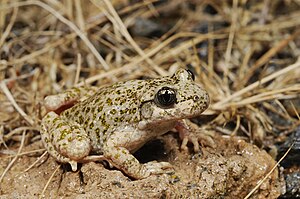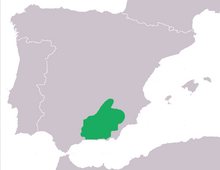Southeast Iberian Midwife Toad
| Southeast Iberian Midwife Toad | ||||||||||||
|---|---|---|---|---|---|---|---|---|---|---|---|---|

Southeast Iberian Midwife Toad ( Alytes dickhilleni ) |
||||||||||||
| Systematics | ||||||||||||
|
||||||||||||
| Scientific name | ||||||||||||
| Alytes dickhilleni | ||||||||||||
| Arntzen & Garcia-Paris , 1995 |
The southeast Iberian midwife toad ( Alytes dickhilleni ) is a rare and endangered amphibian species from the Alytidae family . The German name refers to the area of distribution and the reproductive biology (compare: common midwife toad ); the epithet dickhilleni honors the Dutch herpetologist Dick Hillenius (1927–1987).
description
The southeast Iberian midwife toad is up to 55 millimeters long. Your body is compact. The top is gray-brown or whitish-beige in color. There are irregular dark brown spots, some of which flow together. The skin of the back has no orange or reddish warts, it is only granulated. The fingers are broad and short. The first and fourth fingers are roughly the same length. There are three pads on the underside of the hands. The mating calls are similar to those of Alytes obstetricans . The tail hems of the tadpoles are roughly spotted. A strong, dark band of pigment is located on the upper edge of the tail muscles in the front area.
Occurrence
The distribution area of Alytes dickhilleni includes eastern Andalusia and the mountain regions to the east of it. It extends to the Sierra Nevada in the south and to the Sierra de Alcaraz in the north. The area does not overlap with that of other Alytes species. The species lives at altitudes of 340 to 2100 meters above sea level in pine and oak forests . It can also be found in the open rocky landscape, the subsoil of which is made up of slate or limestone.
Way of life
With the exception of the high altitudes of the mountains, where wintering takes place, the species is active all year round. The breeding season lasts from December to the summer of the following year. The larvae are deposited by the males in clean and clear mountain streams or in anthropogenic water reservoirs that are long enough filled. They typically spend a winter in the body of water before transforming into tiny midwife toads. Young and adult animals feed on spiders, ants and beetles. The viper snake is an important predator .
supporting documents
- Dieter Glandt: Pocket dictionary of amphibians and reptiles in Europe. Quelle & Meyer Verlag, Wiebelsheim 2010, ISBN 978-3-494-01470-8 , pp. 31–32.
Web links
- Photos of the southeast Iberian midwife toad at www.herp.it
- Alytes dickhilleni inthe IUCN 2013 Red List of Threatened Species . Posted by: Jaime Bosch, Miguel Tejedo, Miguel Lizana, Iñigo Martínez-Solano, Alfredo Salvador, Mario García-París, Ernesto Recuero Gil, Jan Willem Arntzen, Rafael Marquez, Carmen Diaz Paniagua, Richard Podloucky , 2008. Accessed September 20 2013.
